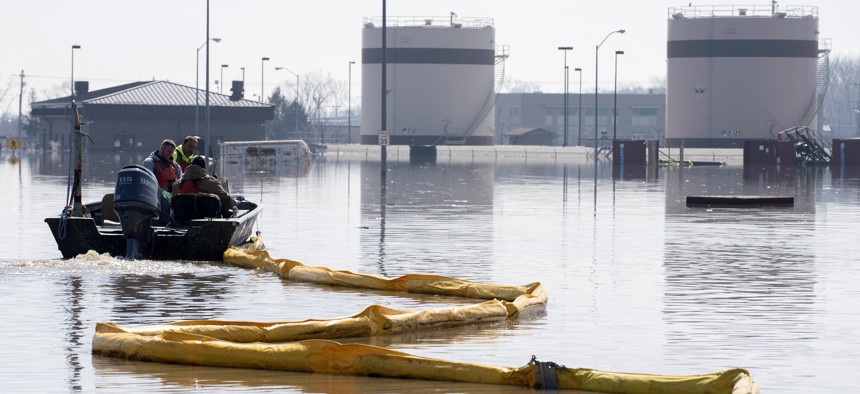
In this March 18, 2019 file photo released by the U.S. Air Force, environmental restoration employees deploy a containment boom from a boat on Offutt Air Force Base in Nebraska, as a precautionary measure for possible fuel leaks in the flooded area. U.S. Air Force
Tyndall and Offutt AFBs Need More Repair Money — and Fast
US Air Force readiness will suffer if Congress doesn’t approve more funds by June.
Last month’s devastating flood at Offutt Air Force Base, Nebraska, didn’t just put a critical military installation underwater. It raised the stakes in an increasingly high-risk game of pass-the-buck when it comes to ensuring the readiness of our military forces.
Offutt is the second major installation to suffer catastrophic storm damage in the past six months. In October, Hurricane Michael all but destroyed Tyndall Air Force Base, forcing the Air Force to move almost every airman and civilian assigned to the Florida base.
Yet even now, six months later, Congress has yet to provide any emergency funding to help in the recovery from that crisis, let alone the flood damage at Offutt. Now that delay is jeopardizing military readiness.
The eight-foot floodwaters at Offutt submerged a mile of the base’s flight line and severely damaged 30 buildings on base. It halted flight operations and training. In the midst of a major exercise at the base, local officials and airmen worked to protect critical areas from the rising waters. airmen filled more than 235,000 sandbags and constructed more than 460 flood barriers in an attempt to minimize the damage. But there was no stopping the Missouri River.
Related: US Air Force: We Need $5 Billion To Fix Weather-Damaged Bases
Related: Lawmakers Tell Pentagon: Revise and Resubmit Your Climate-Change Report
Related podcast:
Nor was there any stopping Hurricane Michael when it made landfall in October. Of 700 facilities at Tyndall, some 480 were damaged, 17 percent beyond repair. An F-22 squadron was divvied up to several other bases and the F-22 training unit is in the process of being moved to Joint Base Langley Eustis in Virginia. Estimates to fully restore the base approach $5 billion.
The storm and flooding have upended the daily lives of Offutt and Tyndall airmen and their families. Homes were wrecked, possessions lost, spouses thrown out of work, and kids uprooted from schools.
The Air Force absorbed the immediate costs but can no longer sustain that without help. If Congress fails to approve emergency funds – and fast – the service will have to start shutting down or cancelling programs and training to make up the shortfall.
Air Force Secretary Heather Wilson has already diverted $250 million from 61 projects at 33 installations in 17 states to cover the relief efforts at Tyndall. That means halting planned repairs to runways, laboratories, dormitories, and airfields in Alaska, Arizona, California, Colorado, Florida, Kansas, Louisiana, Massachusetts, Maryland, Mississippi, Montana, New Mexico, Ohio, Oklahoma, South Carolina, Texas, and Utah; and overseas in Germany, Japan, Portugal, and the United Kingdom.
It was bad enough that the Air Force lost those two critical bases, and that the affected airmen and families have endured political indifference in Washington. Must it also delay these long-planned projects, deepening its readiness crisis and affecting thousands of family members?
Both bases need to be rebuilt as soon as possible — even though both remain at risk from the intense storms and floods of the future. Tyndall is located beside the largest jet-flying training range on the East Coast, one that affords unique ability to fly at supersonic speeds and conduct training operations not possible elsewhere. Offutt, home to Strategic Air Command and its brand new $1.3 billion headquarters, is strategically located smack dab in the middle of the country, maximizing intercept time should the nation’s nuclear headquarters come under attack.
Replicating either base’s capabilities someplace else would cost many multiples more than saving what’s there. Apple spent $5 billion building its new campus in Silicon Valley; new airports cost well over $1 billion. Simply acquiring an equivalent amount of land – assuming one could find enough developable space – would run over $8 billion at a modest $3,000 per acre, before any work was done to build roads, hangars, housing, headquarters, runways, and other support facilities. Moving a military base isn’t like moving a factory. It’s like moving a city.
The Air Force estimates it needs $1.2 billion in 2019 and $3.7 billion in both 2020 and 2021 to rebuild Tyndall and Offutt. The Florida base, which is being rebuilt to withstand 180-mph winds, needs about $1 billion for operations and maintenance projects by the end of September.
Unless a supplemental funding bill is passed by April, Wilson warns, the Air Force will be forced to cease repairs at Tyndall in May and training at Offutt in July. By September, that will mean the loss of 18,000 flight training hours and the grounding of five bomber aircraft because of delayed repairs. Much like the installations, Air Force readiness will take years to recover.
Two supplemental funding bills have been introduced. The House passed one earlier this year. A Senate version amended by Sen. Richard Shelby, R-Alabama, failed in a final vote. These bills would cover just over half of the service’s 2019 operations and maintenance requirements for Tyndall and about a quarter of the base’s reconstruction needs through 2021. That’s a start, but the proposed funding does not include costs for Offutt’s repairs.
Readiness is not something we can control with an on-off switch. It degrades quickly and returns slowly. The restoration costs don’t wait, but grow. However, the desperation of the families is not assuaged by the infighting in Washington.
Our airmen risk their lives and families suffer along with them and risk their livelihoods for our country. We owe them prompt action by funding the Air Force’s requested $4.9 billion in an emergency-supplemental appropriations bill and our nation deserves the Air Force back on station, so they are ready to answer our nation’s call.



